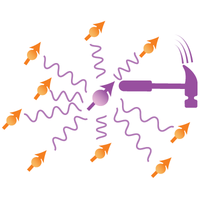Detecting Spin-Bath Polarization with Quantum Quench Phase Shifts of Single Spins in Diamond
IF 11
Q1 PHYSICS, APPLIED
引用次数: 0
Abstract
Single-qubit sensing protocols can be used to measure qubit-bath coupling parameters. However, for sufficiently large coupling, the sensing protocol itself perturbs the bath, which is predicted to result in a characteristic response in the sensing measurements. Here, we observe this bath perturbation, also known as a quantum quench, by preparing the nuclear spin bath of a nitrogen-vacancy (NV) center in polarized initial states and performing phase-resolved spin-echo measurements on the NV electron spin. These measurements reveal a time-dependent phase determined by the initial state of the bath. We derive the relationship between the sensor phase and the Gaussian spin-bath polarization and apply it to reconstruct both the axial and transverse polarization components. Using this insight, we optimize the transfer efficiency of our dynamic nuclear polarization sequence. This technique for directly measuring bath polarization may assist in preparing high-fidelity quantum memory states, improving nanoscale NMR methods, and investigating non-Gaussian quantum baths.Received 3 March 2023Accepted 25 September 2023DOI:https://doi.org/10.1103/PRXQuantum.4.040315Published by the American Physical Society under the terms of the Creative Commons Attribution 4.0 International license. Further distribution of this work must maintain attribution to the author(s) and the published article's title, journal citation, and DOI.Published by the American Physical SocietyPhysics Subject Headings (PhySH)Research AreasNV centersQuantum sensingPhysical SystemsDiamondQuantum spin modelsPropertiesSpinTechniquesDynamic nuclear polarizationOptically detected magnetic resonanceSpin noise spectroscopyCondensed Matter, Materials & Applied PhysicsQuantum Information, Science & Technology

利用金刚石中单自旋量子猝灭相移检测自旋浴偏振
单量子位传感协议可用于测量量子位浴耦合参数。然而,对于足够大的耦合,传感协议本身会干扰槽,这预计会导致传感测量中的特征响应。在这里,我们通过在极化初始状态下制备氮空位(NV)中心的核自旋浴,并对NV电子自旋进行相位分辨自旋回波测量,观察了这种浴扰动,也称为量子猝灭。这些测量揭示了由浴槽初始状态决定的与时间相关的相位。我们推导了传感器相位与高斯自旋浴偏振之间的关系,并应用它来重建轴向和横向偏振分量。利用这一见解,我们优化了动态核极化序列的传递效率。这种直接测量镀液偏振的技术可能有助于制备高保真量子记忆态,改进纳米尺度核磁共振方法,以及研究非高斯量子镀液。美国物理学会根据知识共享署名4.0国际许可协议,doi:https://doi.org/10.1103/PRXQuantum.4.040315Published。这项工作的进一步分发必须保持作者的归属和已发表文章的标题,期刊引用和DOI。发表于美国物理学会物理学科标题(PhySH)研究领域nv中心量子传感物理系统钻石量子自旋模型特性自旋技术动态核极化光学探测磁共振光子噪声光谱凝聚态材料与应用物理量子信息科学与技术
本文章由计算机程序翻译,如有差异,请以英文原文为准。
求助全文
约1分钟内获得全文
求助全文

 求助内容:
求助内容: 应助结果提醒方式:
应助结果提醒方式:


